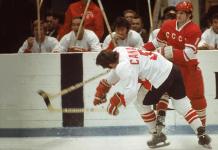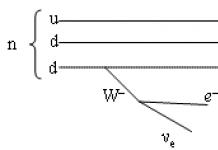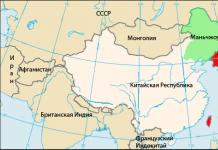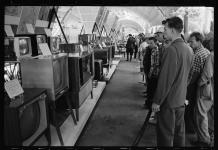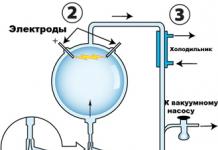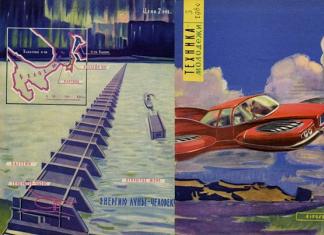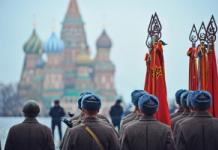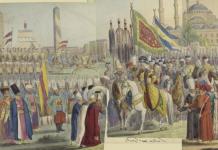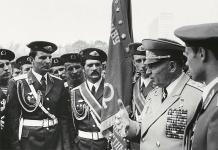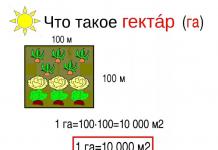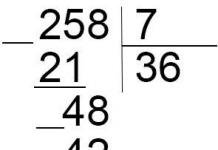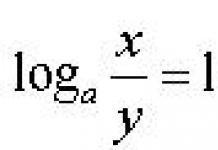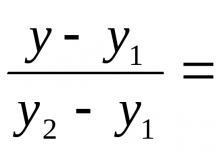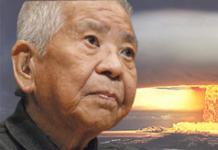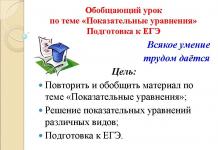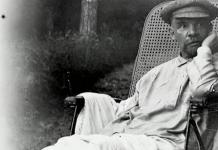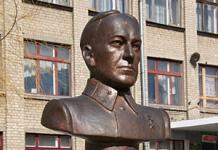Tsushima battle - the final period in the Russian-Japanese war. It happened on May 14, 1905 inside the Korea Strait. The forces were distributed approximately as follows: 8 squadron ships, 3 battleships of coastlines, 8 cruisers, 9 squadron destroyers, and 5 auxiliary cruisers were in the hands of the Russians; 4 squadron battleships, 6 battleships of the coastline, 8 armored cruisers, 16 cruisers, 24 auxiliary cruisers and of 63 destroyers were in the hands of the Japanese. The Russian squadron was led by Admiral Rozhdestvensky, and the fleet of the Japanese Empire was led by Admiral Togo. The main forces of the Russian side were formed in three groups of four ships. Admiral Rozhdestvensky was on the battleship Suvorov. The fleet of the Empire of Japan was divided into eight detachments, two of which included squadron armored ships, led by Togo and Kamimura.
In quantitative terms, the Russian fleet was not inferior to the Japanese. But the Japanese had much more large-caliber and medium-caliber weapons. In the rate of fire, the Russians were also inferior to the Japanese. The Japanese shells also had more explosives. Moreover, the Japanese were much more experienced than the sailors of the Russian Empire, who did not undergo such long training sessions for shooting at different distances.
On the night of May 14, the Russian squadron approached the Korea Strait, lining up in a marching order. Admiral Rozhdestvensky made a huge mistake by not ordering reconnaissance and not darkening the vessel. This made it easy for the Japanese to spot the Russians. The first to find them was the auxiliary cruiser, which informed Togo of this. Rozhestvensky decided not to interfere with the negotiations between the Japanese courts. As soon as Togo learned of the location of the Russians, he directed the main forces towards the enemy. It was planned to surround the main forces of the Russian fleet, and, putting it out of action, completely crush the entire squadron at night.
On May 14, closer to morning, Rozhdestvensky formed the fleet in two wake columns. At half past one, the Russian squadron discovered the Japanese ship. The fleet was rebuilt again, but the opportune moment to attack the Japanese fleet was not used. 19 minutes after finding the enemy, the Russians opened fire, but it was useless. The Japanese fired at the Suvorov and Oslyabya from six battleships and cruisers. By half past three, both of these ships were out of order. After that, until the morning of May 15, almost the entire Russian fleet was destroyed due to the complete dispersal of the fleet. About five ships were taken prisoner: among them there were 4 battleships and one destroyer. Only two destroyers and the cruiser Almaz managed to survive and reach Vladivostok.
The Battle of Tsushima is a demonstration of the influence of large-caliber artillery on which side the advantage will be in the battle. Medium caliber weapons did not particularly affect the outcome of the battle. For Russia, this battle showed the need to develop an updated form of artillery fire control and introduce torpedo weapons.
The task, frankly speaking, is unrealistic. However, historians regard all the actions of the tsarist government of Russia at the beginning of the last century as nothing more than a "chain of absurdities." When the Japanese took the Kwantung Peninsula from China (1895), Russia, being at that moment much stronger than Japan, instead of diplomatic pressure, as Europe always did to her, simply bought the peninsula for 400 million gold rubles. At the time, the most first-class battleship was worth 10 million. It was with this money that the samurai were then able to create a powerful fleet. No wonder smart people joked bitterly: "Russia itself gave loans for its own defeat."
On the night of May 14, 1905, Rozhdestvensky sent a squadron into the Korea Strait in the following composition: five new squadron battleships (four - of the Borodino and Oslyabya types), three old squadron battleships (Navarin, Sysoy Velikiy and Emperor Nicholas I "), an armored cruiser (" Admiral Nakhimov "), three coastal defense battleships (of the" Admiral Ushakov "type), four cruisers of the first rank and the same number of the second, nine destroyers and eight transports. The crews numbered 12 thousand people. The Russian squadron was awaited in the strait by the Japanese fleet consisting of four battleships, eight armored cruisers, 15 cruisers and 63 destroyers and destroyers. At first glance, the Russian squadron in terms of the number of armored ships was not inferior to the Japanese (12 to 12), but inferior to her in quality. We will not dwell on the details of the battle, they are quite complete, moreover, for each ship, are set out in the numbers of NIT for years.
At 12:05 pm on May 14, the Russian squadron entered the battle in the formation of two wake columns: the eastern column was headed by ZP Rozhestvensky himself on the battleship "Prince Suvorov", the western - by the battleship "Oslyabya". The commander of the Japanese fleet, Admiral Heihachiro Togo (1848-1934), decided to apply the technique described by S.O. Makarov - covering the head of the wake column with the successive destruction of the lead ships. At 13:49 the battle began. At first, Togo missed: he believed that the Russians had a speed of 12 knots, while they gave only 9. The Japanese admiral was forced either to take a risk - to make a left turn, or to delay the maneuver indefinitely. It is difficult to imagine how events would have developed if instead of Togo a less decisive person was on the bridge of the flagship, but he took a risk, although he understood that with an active attack by the Russians, he would suffer heavy losses. But after 15 minutes, maneuvering at a speed of at least 16 knots, the Japanese fleet still managed to take an advantageous position (put a kind of stick on the letter T) and fire onboard concentrated fire on Suvorov and Oslyab. Zeroing lasted only 10 minutes, after which the Japanese literally bombarded the lead ships of the Russians with shells. The entire brunt of the battle was borne by the five leading ships against 12 enemy ships.

Although the Japanese high-explosive shells did not penetrate the armor, since even the new Russian ships did not have more than 60% of the side armor, they produced great destruction and caused fires. In addition, well-trained Japanese gunners achieved a rate of fire almost twice as high as the Russians. To top it all off, Rozhdestvensky at this time began to rebuild the ships from two into one column, so they reduced their already low speed.
At 14:25 the burning Oslyabya went out of order and after 15 minutes rolled over and sank. At 14 hours 30 minutes "Prince Suvorov" went out of action, but for another five hours it repelled the attacks of enemy cruisers and destroyers until it was sunk by torpedoes. So, 40 minutes after the start of the battle, the Russian squadron lost two modern battleships. Russian ships also tried to conduct concentrated fire on one of the Japanese battleships, but due to their lack of experience in controlling long-range shooting, they could not do this.


The descending fog interrupted the battle for almost half an hour. But at 15:40 the squadrons met again. The Japanese again managed to cover the head of the Russian column. Ahead was the "Sysoy the Great". Unable to withstand the massive fire, he left the formation after 10 minutes. His place was taken by the battleship of the guard crew "Emperor Alexander III". The ship steadfastly led the squadron for almost three hours, but at 18 hours and 30 minutes it went out of order, and after 20 minutes it turned over and sank. Having become the lead "Borodino", on which the fire of the entire Japanese fleet was now concentrated, at 19 hours 10 minutes it also capsized. The last of the remaining new ships, the battleship Oryol, was also severely damaged, which after the death of Borodino was the lead ship until it was overtaken by the battleship Emperor Nicholas I, where the junior flagship was counter-admiral Nikolai Ivanovich Nebogatov (1849-1922). So in the daytime battle the Russian squadron lost its best ships.
During the Battle of Tsushima, just 50 minutes after the first shot, a Russian 305-mm armor-piercing projectile pierced the 6-inch frontal armor of the aft turret of the main battery of the Japanese battleship Fuji and exploded just above the breech of the left twelve-inch gun. The force of the explosion threw overboard a heavy armor plate-counterweight, which covered the rear of the tower. All who were in it were incapacitated (eight people were killed, nine were wounded). But the most important thing is that the red-hot fragments ignited the powder charges raised from the cellars.

At the same time, over 100 kilograms of gunpowder flared up, fiery spray flew in all directions, and the flame ran down the elevator. Another second and instead of the battleship - a column of thick black smoke hundreds of meters high and debris flying in the air. English cordite gunpowder was very prone to explosion when burnt quickly. But in this situation, the ship of Admiral Togo was fabulously lucky: one of the fragments interrupted the hydraulic main, and the water gushing under enormous pressure extinguished a dangerous fire, and it did it no worse than a modern automatic fire extinguishing system.
Who knows what turn the whole battle would have taken when almost at the very beginning one of the four Japanese battleships took off. Of course, if it did not even change the fate of the entire battle, then at least somewhat brightened up the shame of the most difficult defeat of the Russian fleet.
After sunset, at 20:15, the Japanese threw their 63 destroyers on the remnants of the Russian squadron. By this time, the squadron ceased to exist as an organized combat force, each ship acted on its own.
The first to be torpedoed were the cruisers Admiral Nakhimov and Vladimir Monomakh. Then the battleships Sysoy Veliky and Navarin received fatal blows. After that, only weak or outdated battleships remained in the Russian squadron (the new battleship "Eagle" by this time had exhausted its combat capabilities). In the morning, Japanese ships intercepted and sunk the coastal defense battleship "Admiral Ushakov", the cruisers "Dmitry Donskoy" and "Svetlana". The commander of the newest cruiser "Oleg" Captain First Rank Dobrotvorsky, considering that after the death of the battleships, the breakthrough to Vladivostok loses all meaning, decided to retreat to the south. Aurora and Zhemchug stood in his wake. The direct duty of these cruisers was to let the battleships pass to the southwest and protect them from the attacks of enemy destroyers, but they did exactly the opposite - they threw them into the night, without protecting them from mine attacks. This detachment of fast ships headed for Manila, where on May 21 the cruisers were disarmed and interned until the end of the war. The same fate befell the destroyer Bodry and two transports.
On May 15 at 11 o'clock the remaining ships (the battleships "Orel", "Nikolay I", the cruiser "Izumrud" and two battleships of the coastal defense) made up the squadron of Rear Admiral N.I. And by order of the admiral, the Andreevskie flags were lowered. Nebogatov subsequently motivated his decision to surrender with the desire to save two thousand lives from inevitable and useless death. It is, of course, possible to explain his act by humanistic considerations, but it is impossible to justify by honor. On the battleship "Eagle" an attempt was made to sink the ship by opening the Kingstones, which was noticed and stopped by the Japanese in time. In captivity, the sailors of the ships surrendered without a fight met with a sharp hostility from other Russian prisoners. The high-speed Emerald (25 knots), having analyzed the surrender signal, did not follow it. The cruiser made a breakthrough and easily broke away from the enemy. However, when approaching Vladivostok, he ran aground at night and was blown up by his team.

The ships of the Pacific Ocean squadron passed 33 thousand kilometers from Kronstadt to Tsushima and entered the battle on the move, in which on May 14-15, 1905, the Russian fleet suffered the most severe defeat in its entire three-century history. The battle of Tsushima ended in almost complete destruction of the Russian squadron: of the 17 ships of the first rank, 11 were killed, two were interned, and four fell into the hands of the enemy. Of the four cruisers of the second rank, two were killed, one was interned, and only Almaz reached Vladivostok, two destroyers also arrived there. More than 5 thousand people (of which 209 officers and 75 conductors) died ( in Tallinn (Estonia) in the Orthodox Church of Alexander Nevsky to the right of the main entrance, two large plaques hang on the wall with the names of the sailors who died in the Battle of Tsushima), and 803 were injured (172 officers, 13 conductors). In Japanese captivity there were 7,282 sailors, among whom was the squadron commander, Vice-Admiral ZP Rozhestvensky. The losses of the Japanese fleet were much more modest: three destroyers were sunk, several ships were badly damaged, 116 people were killed, 538 were wounded. ... The prestige of the empire's military power has been lost. From a country that had the third fleet in the world, Russia, having lost almost all the main forces of its fleet, turned into a minor maritime power, like Austria-Hungary. The decline in Russia's prestige in the eyes of world powers led to a destabilization of the balance of power in the world, which was one of the many reasons for the First World War.
Why did the Russian battleships die? For over 100 years, Russian military historians and specialists have asked themselves the question: how could this have happened? A very widespread version - the reason for the defeat in the complete mediocrity of Z. P. Rozhestvensky. However, this is not at all true. He was a capable organizer, possessed great energy, efficiency and willpower, strong character and perseverance, was a demanding boss. In a word, he was an excellent administrator who was quite suitable for leading the most difficult, unprecedented transition of the fleet to the Far East. However, for a real naval commander, one must also have high tactical training, and most importantly, have the gift of foresight of the commander. This Rozhestvensky really lacked, but at the same time, he did not make a single more or less gross mistake. Therefore, to accuse a person that he is not Nelson or Reuter is, to say the least, stupid. Of course, Rozhestvensky was not untalented, but he was not a genius either, and alas, he could not accomplish such a miracle as the Dutch admiral did near the Texel Island (1673).

Damage to the battleship "Eagle" received in the battle of Tsushima (photo 1905)
Many reproach the admiral for the misuse of the four new Borodino-class battleships with 18-knot speed and turret-mounted medium-caliber artillery, built in 1901-1904. just counting on the alleged opponents. Indeed, if the 1st armored detachment was a completely amalgamated formation with gunmen well trained for squadron firing, and if it operated on the battlefield relatively independently, maneuvering at full speed, it could and should (according to calculations) turn the tide of the battle in favor of the Russian squadron. In fact, these ships in the same column with the "old men" were placed in completely abnormal conditions, which paralyzed their main combat advantages. The level of training of the squadron hardly made it possible to implement this option of fighting, since the battleships went into battle almost directly from the slipway.

Maybe it's the quality of the ships? If we compare the characteristics of the Russian battleships of the Borodino type and the Japanese ones of the Mikaza type, we can see that the former are only slightly inferior to the latter only in the thickness of their armor. How, then, can one explain their so inglorious death in the Battle of Tsushima?
The analysis of the artillery of the sides explains a lot. Indeed, the decision of the Maritime Technical Committee (MTK) to adopt new lightweight projectiles in 1892 had tragic consequences, which should have contributed to a significant increase in their initial speed, and, consequently, to an increase in penetration at short distances. This innovation was justified at combat distances of up to 2 miles (3.2 km), which the Russian artillery service rules considered the ultimate. If the 305-mm projectile of the 1886 sample weighed 445.5 kilograms, then the 1892 sample - only 331.7 kilograms!
However, the general trend in the tactics of armored fleets, "not caught" by the ITC, was a rapid increase in the combat distance, which reached 5-7 miles (9-13 km) in the Battle of Tsushima. This, as well as the use of smokeless powder, which increased the range by almost three times, negated almost all the advantages of light projectiles in close combat. But at long distances they had low penetration and high dispersion. In addition, the Russian shells had a very low explosive content. There were frequent cases when the shells did not explode when they hit the unarmored hull, since they had a coarse fuse. The flagship of the Japanese fleet, the battleship Mikaza, was hit by 30 Russian shells, 12 of which were 305-mm. Most of them did not explode, and Mikaza not only remained afloat, but also largely retained its combat capability (105 killed and wounded). In principle, this number of "suitcases" should have been more than enough to sink it.

Vice-Admiral ZP Rozhestvensky understood well that one should not engage in battle with unprepared artillerymen. Therefore, while staying near the island of Madagascar, they planned multi-day artillery exercises. However, the steamer "Irtysh" with ammunition for practical firing just before the squadron left, suffered an accident. Another vessel was requested, but the transport was quickly repaired, and in early 1905 he joined the 2nd squadron off the coast of Madagascar. To the displeasure of the squadron commander, the Irtysh delivered only coal and boots (?), And the expected shells, it turns out, were not planned at all.
One of the minor officials of the Ministry of Finance sent the training shells "for better safety" to the Far East by land. Quite sincerely arguing that it is possible to study in the base, and the treasury will save 15 thousand rubles on transportation. While the transport that had suffered an accident was being repaired in Libava, the shells were unloaded and sent along the Siberian railway, and they did not even find it necessary to notify Z.P. Rozhestvensky about it. It was impossible to spend real ammunition for training purposes, so in three months only four firing was carried out at distances of up to 3 miles (5.4 km). It is interesting to note that the investigation carried out did not find any vested interests in the actions of the official. Our wise ancestors said correctly: "A fool is more dangerous than an enemy." Alas, such an attitude to the military training of the army and navy in Russia, apparently, was inherited by the modern Ministry of Finance.

Locks of the Russian turret 305-mm gun mod. 1895 Obukhovsky plant
The Russian artillery had a low rate of fire due to the long opening and closing times of the 305-mm guns mod. 1895 and low rate of ammunition supply. The elevation angles of the trunks were clearly insufficient for conducting combat at long distances. Armstrong's guns of the Japanese in these matters gave a big head start to the Russians. There were no good, modern sights either. New optical rangefinders have not yet been mastered by rangefinders. The training of gunners of new ships, which did not conduct the required number of training sessions, was at a low level. We also did not have time to work out the organization of centralized control of the firing of several ships and the squadron as a whole. All this sharply reduced the effectiveness of artillery fire.
During the battle, flaws in the protection and design of the hull were revealed, which affected the survivability of the ships. The fire control devices were not covered by armor and failed on the first hit. The ships were heavily overloaded, so much so that the armor belt was almost completely submerged (the draft exceeded the design by almost a meter). Therefore, the Japanese fired high-explosive shells. In addition to "sinking" the armor, the overloaded ship quickly lost stability and instantly capsized. The main reason for the overload is a huge supply of coal (850 tons above the norm), which the battleships were forced to take in order to reach Vladivostok. The speed decreased significantly due to the intensive fouling of the underwater part of the hull during many months of sailing in the tropics. All these troubles could be excluded if additional forces were transferred to the Far East in a timely manner. However, these design flaws were characteristic not only of the Russians, but also of the squadron battleships of all other countries. It became clear that fundamentally different ships were needed for the new battle conditions. The battle revealed the high complexity of targeting different-caliber guns (with the existing fire control systems), as well as the low importance of intermediate and medium-caliber projectiles for hitting large enemy ships, which ultimately led to the abandonment of the existing principles of the location of artillery weapons in favor of dreadnoughts. That is, large artillery ships have ceased to be equipped with medium and intermediate caliber barrels.

His Serene Highness Vice-Admiral A. A. Lieven (1860-1914)
However, not everything boils down to technical aspects - the main reason for the defeat lies much deeper, and not only in the field of shipbuilding. “Many people blame our technology. The shells were bad, the ships were slow and poorly defended, the battleships were capsized, etc. But most of these accusations are unfair. Of course, our factories are not at the height of the English ones, but these shortcomings only lead to the fact that we have to spend more time and money to achieve the same goals. If we take a closer look at the main shortcomings of our technique, we will make sure that they come not so much from unsatisfactory performance as from a wrong design. Why are our shells bad? Not because they do not know how to make them, but because the opinion was established among the artillerymen that it was precisely such shells that should be fired. They were considered good ... ". This is what His Serene Highness Prince Vice-Admiral Alexander Aleksandrovich Lieven (1860-1914), chairman of the commission for describing the naval part of the Russo-Japanese War, wrote in 1908.
He further pointed out: “Battles are not being lost on purpose. Therefore, I think I have the right to say that the poor condition and unsuccessful behavior of our fleet resulted from the ignorance of the needs of war of all our personnel. Why did this happen? Because the thought of war has always been relegated to the background as unpleasant. The propaganda of the ideas of universal peace found a particularly favorable ear in Russia. We built battleships and preached peace, rejoiced at the revival of the fleet and hoped with this fleet not to defeat the enemy, but to maintain friendly relations ... Who has not seen that we have fake reviews and maneuvers, that shooting is too rare. But all this was tolerated, everything was justified by a lack of funds. After all, time endured, no war was foreseen ... That is why in theory we lied and surprised the world with our orders. And there is one root reason for all this - WE DIDN'T CONSCIOUS OURSELVES TO BE MILITARY. " In the issues of the "Ship Catalog" on Russian battleships, we tried to reveal to you, dear readers, the reasons for this state of affairs, as you remember, they were both objective and subjective.
Why did such a situation develop?
Peter the Great said: "A brave heart and serviceable weapons are the best defense of the state."
The serviceability of a weapon depends on those in whose hands it is. That is, from the state of the spirit of the people. What was the state of this most important element of combat power before the war? Considering that today it is very fashionable to throw mud at the entire past (and not only the Soviet one), let us give the floor to the participants of the Russo-Japanese War themselves.

Here is what General Alexander Andreevich Svechin (1878-1938), one of the most literate General Staff officers of that time, wrote on the eve of the war:
“From the departments, in the literature and the press, views are held that nationalism is an obsolete concept, that patriotism is not worthy of a modern“ intellectual ”who should equally love all of humanity, that the army is the main brake on progress, etc. From the university environment, from literary circles, from the offices of the editorial offices, these ideas, destructive for any state, are spreading in wide circles of Russian society, and every dumbass who joins them, thereby, as it were, acquires a patent for the title of "advanced intellectual" ...
The logical conclusion from such a worldview is the denial of all military valor and contempt for military service as a stupid and harmful activity ... The Japanese army enters the battle, accompanied by the enthusiastic sympathy of all its people - from the highest strata to the lowest. Behind the back of the Russian army there will be a direct hostile attitude of our "advanced intelligentsia" and everything that imitates it. This is where Japan's true strength and Russia's weakness lie. " The practice of martial arts believes that the outcome of a fight, as a rule, is decided before it starts. In this respect, the personnel of the Russian squadron was psychologically much weaker than that of Togo.

History repeats itself, because it has such a property. Therefore, we will finish our immersion into the sad past with the words of Vice Admiral S.O. Makarov: “Every military man or person involved in military affairs, so as not to forget why he exists, would do the right thing if he kept the inscription in a prominent place - REMEMBER THE WAR ".
Found a typo? Select the fragment and press Ctrl + Enter.
Sp-force-hide (display: none;). Sp-form (display: block; background: #ffffff; padding: 15px; width: 960px; max-width: 100%; border-radius: 5px; -moz-border -radius: 5px; -webkit-border-radius: 5px; border-color: #dddddd; border-style: solid; border-width: 1px; font-family: Arial, "Helvetica Neue", sans-serif; background- repeat: no-repeat; background-position: center; background-size: auto;). sp-form input (display: inline-block; opacity: 1; visibility: visible;). sp-form .sp-form-fields -wrapper (margin: 0 auto; width: 930px;). sp-form .sp-form-control (background: #ffffff; border-color: #cccccc; border-style: solid; border-width: 1px; font- size: 15px; padding-left: 8.75px; padding-right: 8.75px; border-radius: 4px; -moz-border-radius: 4px; -webkit-border-radius: 4px; height: 35px; width: 100% ;). sp-form .sp-field label (color: # 444444; font-size: 13px; font-style: normal; font-weight: bold;). sp-form .sp-button (border-radius: 4px ; -moz-border-radius: 4px; -webkit-border-radius: 4px; b ackground-color: # 0089bf; color: #ffffff; width: auto; font-weight: 700; font-style: normal; font-family: Arial, sans-serif;). sp-form .sp-button-container (text-align: left;)
Tsushima battle
| Theater | Pacific Ocean |
| Place | Tsushima Island, East China Sea |
| Period | Russo-Japanese war |
| The nature of the battle | General battle |
Opponents
Force commanders
Forces of the parties
Tsushima battle(Japanese 対 馬海 戦) - the largest battle in the era of the pre-dreadnought armored fleet, which took place on May 27-28, 1905. The battle ended with the complete defeat of the 2nd squadron of the Pacific Fleet under the command of Z.P. Rozhestvensky by the forces of the Joint Japanese Fleet under the command of Admiral H. Togo ... The results of the battle finally predetermined the victory of Japan in the Russo-Japanese War, and also significantly influenced the development of world military shipbuilding.
common data
The sudden start of the Russo-Japanese War with a night attack by the ships of the 1st Pacific Squadron gave the Japanese the opportunity to gain strategic initiative and superiority over the Russian naval and land forces. To strengthen the Russian fleet and then gain supremacy at sea, the command decided to form the 2nd and 3rd Pacific squadrons.
The preparation of the 2nd TOE dragged on from April to September 1904 due to various difficulties associated with the supply, repair, completion and commissioning of new ships of the 1898 program. and provisions, after which on October 2 began the transition to Vladivostok. Having made an unprecedented passage of 18 thousand miles, which required many efforts, Rozhdestvensky's squadron entered the Korea Strait on the night of May 14.
Characteristics of the parties involved
Russian side
Compound
Naval action plan
ZP Rozhestvensky set the squadron the task of reaching Vladivostok by breaking through at least a part of the squadron (this contradicted the directive of Nicholas II, which demanded “to seize the Sea of Japan”), which is why he chose the shortest route, which ran through the Korea Strait. The vice-admiral could not count on any significant help from the Vladivostok squadron, and also refused to conduct reconnaissance. At the same time, the Russian commander did not develop a detailed battle plan, giving only a few general instructions to individual ships. That is, the squadron was supposed to bypass Japan and not engage in battle until it arrived in Vladivostok. And to take possession of the Sea of Japan was to destroy transports by fighting on communications. did not fulfill and doomed the squadron to death. It can be said that he sabotaged the transition and simply presented the squadron to the enemy.
The commander of the Russian fleet, Vice Admiral Zinovy Rozhdestvensky, is criticized by historians for adhering to defensive tactics in battle against the Japanese. Starting from the departure from the Baltic, he devoted very little time to training the crew, in particular the artillerymen, and the only serious maneuver was made only on the eve of the battle. There is a strong impression that he did not trust his subordinates and did not inform them about his plans for the battle, and during the battle he was going to lead the ships from his flagship "Suvorov".
Japanese side
Compound
Naval action plan
The main goal of Admiral H. Togo is to destroy the Russian squadron. He, knowing about the passive tactics of the Russians, following in the wake columns, decided to act with small maneuverable formations (4-6 ships), which would, using their speed, attack the Russian wake column from favorable course angles. The primary targets of these formations are the lead and end ships of the column. The intelligence data added to the Japanese admiral's confidence, thanks to which he knew where, in what composition and how the Russian squadron was moving.
The course of the battle
| Time | Event |
|---|---|
| On the night of May 14 (27), 1905, the Russian squadron approached the Tsushima Strait. She moved at 5-knot speed in three columns, observing blackout. A reconnaissance detachment marched ahead in the formation of the wedge. The main forces marched in two wake columns: the 3rd armored detachment on the left and a detachment of cruisers in its wake, the 1st and 2nd armored detachments on the right. | |
| 04 hours 45 minutes | Admiral Togo on board IJN Mikasa, receives a radiogram from the scout of the auxiliary cruiser IJN Shinano Maru containing information about the location and approximate course of the Russian squadron. |
| 06 hours 15 minutes | Admiral Togo, at the head of the United Fleet, leaves Mozampo to meet Z.P. Rozhdestvensky's squadron, which entered the eastern part of the Tsushima Strait |
| 07 hours 14 minutes | Russian squadron notices a class 3 Japanese cruiser IJN Izumi... It becomes clear that the Russian connection has been found, but Rozhestvensky does not cancel his order and maintains radio silence. |
| OK. 11 h. | A detachment of Japanese cruisers ( IJN Kasagi, IJN Chitose, IJN Otowa, IJN Niitaka), were fired upon by "Oslyabey", "Prince Suvorov" and battleships of the III detachment and hastily retreated. By order of Rozhestvensky, “do not throw shells,” the unsuccessful shooting was stopped. |
| 12 hours 00 minutes - 12 h. 20 min. | The 2nd TOE changes its course to Vladivostok and maintains its 9-knot speed. The Japanese reconnaissance cruisers are again discovered, which forces Rozhestvensky to cancel the maneuver of building a front of 12 battleships. |
| 13 hours 15 minutes | "Sisoy the Great" reports with a signal about the detection of the main forces of the Japanese fleet, crossing the course of the squadron from right to left. |
| 13 hours 40 minutes | The Japanese ships crossed the course of the Russian squadron and began to turn to a course parallel to it, so as not to diverge on countercourses (and to avoid a short-term battle). |
| Day fight May 14 | |
| 13 hours 49 minutes | "Prince Suvorov" made the first shots at IJN Mikasa from a distance of 32 kb. After him on the Japanese flagship opened fire "Alexander III", "Borodino", "Eagle", "Oslyabya", possibly "Navarin". Sisoy the Great and all three coastal defense battleships are firing at the Nissin and Kasuga, after 5-10 minutes. both "Nicholas I" and "Admiral Nakhimov" opened fire. |
| 13 hours 51 minutes | First shot with IJN Mikasa, after which the rest of the Japanese ships begin to fire: IJN Mikasa, IJN Asahi, IJN Azuma- on "Suvorov"; IJN Fuji, IJN Shikishima and most of the armored cruisers - according to "Oslyab"; IJN Iwate and IJN Asama- according to "Nicholas I". |
| OK. 14 h. | Togo flagship IJN Mikasa comes out from under fire "Borodino", "Eagle" and "Oslyabya", having received in the first 17 minutes. battle 19 hits (of which five - 12-inch shells). From 14 o'clock, no more than twelve large-caliber guns fired on him. Despite the flooding of the coal pit as a result of breaking through casemate No. 1, it was not possible to disable the ship. |
| 14 hours 09 minutes | As a result of Russian artillery fire, only IJN Asama, which for 40 min. got out of the fight. |
| OK. 14 hours 25 minutes | "Oslyabya", which from the first minutes of the battle received serious damage (the bow tower was destroyed, the 178-mm armor plate of the main belt came off, a hole formed in the bow of the left side along the waterline, which caused flooding), and the "Prince Suvorov", engulfed in fires, were out of order. This led to the loss of combat control of the main forces of the squadron. |
| 14 hours 48 minutes | The Japanese ships made a "all of a sudden" turn and began to fire at Borodino. |
| OK. 14 h. 50 min. | "Oslyabya" turned over and began to go under the water. |
| 15 hours 00 minutes | "Sisoy the Great" and "Navarin" received holes near the waterline, the commander was mortally wounded on the last ship. |
| 15 hours 40 minutes | The beginning of the battle between the Russian forces, led by "Borodino" and the Japanese at a distance of 30-35 kb, lasted about 35 minutes. As a result, all the towers of "Prince Suvorov" were put out of action, the commander of "Borodino" was seriously wounded, a fire started on the "Sisoy Velikiy", due to which the ship was temporarily out of order. "Alexander III" was seriously damaged. Received heavy damage from the shooting of Russian ships IJN Mikasa and IJN Nisshin. |
| 17 hours 30 minutes | The destroyer "Buyny" removed from the completely out of order "Suvorov" the surviving staff officers and the wounded in the head Admiral ZP Rozhestvensky. |
| 17 hours 40 minutes | The Russian squadron led by "Borodino" was fired upon by the detachment of Admiral Togo that overtook it, which led to the stretching of the Russian formation and lagging behind the column of "Alexander III". |
| 18 hours 50 minutes | "Alexander III", being fired at by Kh. Kamimura's cruisers from a distance of about 45 kb, lost stability, rolled over to the starboard side and soon sank. |
| 19 hours 00 minutes | The wounded Rozhdestvensky formally transferred the command of the squadron to N.I. Nebogatov with the order to go to Vladivostok. |
| 19 hours 10 minutes | "Borodino", possibly as a result of hits from 12-inch shells with IJN Fuji, which led to the explosion of ammunition, rolled over to starboard and sank. |
| 19 hours 29 minutes | "Prince Suvorov" was finally sunk as a result of four torpedo hits fired at point-blank range by Japanese destroyers. |
| OK. 20 h | NI Nebogatov, carrying out the last order of the commander, headed for Vladivostok, increasing the speed to 12 knots. |
| As a result of the day's battle, four of the five best Russian battleships were sunk; "Eagle", "Sisoy the Great", "Admiral Ushakov" received serious damage, which affected their combat capability. The Japanese won this battle largely due to their tactics: general and use of artillery (concentration of fire on the lead ships of the Russian squadron, high shooting accuracy). | |
| Fight on the night of May 14-15 | |
| At night, Nebogatov's squadron was attacked by Japanese destroyers, from which the already damaged ships mostly suffered. In general, Russian ships successfully repelled mine attacks (possibly due to the non-use of searchlights and distinctive lights). Two Japanese destroyers (№№34, 35) were killed by the fire of Russian ships, 4 more ships were seriously damaged. | |
| OK. 21 h. | The cruiser "Admiral Nakhimov", finding itself after turning on the combat lighting, received a mine hole in the bow coal pit. |
| OK. 22 h. | Whitehead's mine, fired from a Japanese destroyer, hit the stern of the Navarina, causing it to sink to the stern tower. A mine hit in the bow was also received by Vladimir Monomakh. |
| 23 hours 15 minutes | As a result of the mine explosion, Sisoy the Great lost its steering control. |
| OK. 02 h. | The damaged Navarin was discovered by Japanese destroyers who fired 24 Whitehead mines at it. The battleship, which was hit, soon sank. |
| Individual battles on May 15 | |
| On the afternoon of May 15, almost all Russian ships trying to independently reach Vladivostok south of Dazhelet Island were attacked by the superior forces of the Japanese fleet. | |
| OK. 05 h. | The destroyer "Shiny" was sunk by her team to the south of the island. Tsushima. |
| 05 hours 23 minutes | As a result of an unequal battle with the cruiser IJN Chitose and a fighter IJN Ariake, which lasted more than an hour, the destroyer "Impeccable" was sunk. |
| 08 h 00 min | The battleship "Admiral Nakhimov" was sunk to the north of the island. Tsushima. |
| 10 hours 05 minutes | Sisoi the Great sank as a result of being hit by a Japanese mine. |
| 10 hours 15 minutes | A detachment of ships of Admiral Nebogatov (battleships "Emperor Nicholas I" (flagship), "Eagle", "General-Admiral Apraksin", "Admiral Senyavin") ended up in a half-ring of five Japanese combat detachments and surrendered. Only the II rank cruiser Emerald managed to break out of the Japanese encirclement. |
| OK. 11 h. | After an unequal battle with 2 Japanese cruisers and 1 destroyer, the crew scuttled the cruiser Svetlana. |
| 14 hours 00 minutes | The crew scuttled the Vladimir Monomakh. |
| 17 hours 05 minutes | The commander of the 2nd TOE, Vice Admiral ZP Rozhestvensky, who was on the destroyer "Bedovy", surrendered. |
| 18 hours 10 minutes | The Japanese cruisers Yakumo and Iwate sunk the Russian battleship Admiral Ushakov. |
Timeline on schematic maps
red - Russians
white - Japanese
 |
 |
 |
 |
 |
 |
 |
 |
 |
 |
Loss and bottom line
Russian side
The Russian squadron lost in killed and drowned 209 officers, 75 conductors, 4761 lower ranks, a total of 5045 people. 172 officers, 13 conductors and 178 lower ranks were wounded. 7282 people were taken prisoner, including two admirals. 2,110 people remained on the captured ships. The total personnel of the squadron before the battle was 16,170 people, of which 870 broke through to Vladivostok. Of the 38 ships and vessels participating from the Russian side sank as a result of the enemy's combat impact, flooded or blown up by their crews - 21 (including 7 battleships, 3 armored cruisers, 2 armored cruisers, 1 auxiliary cruiser, 5 destroyers, 3 transports) , surrendered or 7 were captured (4 battleships, 1 destroyer, 2 hospital ships). Thus, the cruiser "Almaz", the destroyers "Bravy" and "Grozny", the transport "Anadyr" could be used to continue the hostilities.
Japanese side
According to the report of Admiral Togo, a total of 116 people were killed in the Japanese squadron, 538 were wounded. According to other sources, 88 people were killed on the spot, 22 died on ships, 7 in hospitals. 50 disabled people were found unfit for further service and were dismissed. 396 of the wounded recovered on their ships and 136 in hospitals. As a result of the fire, the Japanese fleet lost only two small destroyers - No. 34, 35 and the third, No. 69 - as a result of a collision with another Japanese destroyer. Of the ships participating in the battle, shells and fragments did not hit the cruisers Itsukushima, Suma, Tatsuta and Yaema. Of the 21 destroyers and 24 destroyers exposed to fire, 13 destroyers and 10 destroyers were hit by shells or fragments, and several were damaged due to collisions.
Main consequences
The tragedy that occurred in the waters of the Korea Strait had a serious impact on the internal political situation in Russia. The defeat led to the rise of the social and political movement in the country, including the revolutionary and separatist nature. One of the most dire consequences for Russian Empire there was a decline in its prestige, as well as the transformation into a secondary maritime power.
The battle of Tsushima finally tipped the balance in favor of Japan's victory, and soon Russia was forced to conclude the Portsmouth Peace Treaty. Final dominance of the sea also remained with Japan.
From the point of view of military-technical influence on the development of shipbuilding, the experience of the Tsushima battle once again confirmed that the main means of striking in battle was large-caliber artillery, which decided the outcome of the battle. Medium caliber artillery did not justify itself due to the increase in the combat distance. This led to the development of the so-called "big guns only" concept. An increase in the penetrating ability of armor-piercing and destructive high-explosive shells required an increase in the armor area of the ship's side and an increase in horizontal armor.
There are defeats that turn out to be a blessing for the country when the sobering authorities change state policy, turning the country into a peaceful and prosperous power. Such a defeat, for example, was once suffered by Sweden near Poltava. And Japan, which lost World War II, does not look too shabby. However, there are also such defeats, from which countries then suffer for centuries. Tsushima, the last battle in the Russo-Japanese War of 1904-1905, became such a defeat. The word "Tsushima" became a household word for Russians - the same as the word "Stalingrad" later became for the Germans, for the Americans - "Pearl Harbor", for the Japanese themselves - "Hiroshima". The consequences of the Battle of Tsushima for Russia were truly catastrophic - in the end, they led to the death of the Russian Empire, the October Revolution and 70 years of communist rule. This battle took place exactly one hundred years ago, on May 14, 1905 (May 27, new style).
The battle, in which Russia actually lost its fleet, was preceded by a year of incessant setbacks on the fronts of the Russo-Japanese war. Formally, this war was started by Japan, but its start was inevitable - the two countries shared spheres of influence in Korea and Manchuria. After the victory over China in 1894-1895, Japan, under the Shimonoseki Treaty of 1895, received the islands of Taiwan and Penghuledao, as well as the Liaodong Peninsula, which it had to give up under pressure from Russia and France. In 1896, Russia received a concession from the Chinese government to build a railway through Manchuria, and in 1898 rented the Kwantung Peninsula with Port Arthur from China. At the same time, Russia received the right to create a naval base on it. In 1900, Russian troops entered Manchuria.

This war, which lasted more than a year, revealed serious shortcomings in the command system of the Russian army and navy. Due to gross mistakes and miscalculations in preparing for war, in particular - underestimating the enemy, Russia was losing battle after battle. In August 1904 - defeat at Liaoyang, in September - on the Shahe River, in December 1904, the besieged Port Arthur fell. The head of the Kwantung fortified region, Lieutenant General Stoessel, signed the surrender of the fortress, despite the fact that the garrison and squadron could and wanted to resist. In February 1905, Japanese forces inflicted a heavy defeat on the Russian army at Mukden.
This whole long chain of failures heated up the situation in the country to the limit, and the Russian government decided to send the 2nd Pacific Squadron, united with the 3rd, to help the then encircled Port Arthur garrison. In addition to Port Artrur, the task of breaking through to the port of Vladivostok was set before the compound under the command of Vice Admiral Rozhdestvensky. This would lead to an increase in the military presence of Russia in the Far East and would affect the entire course of the Russo-Japanese war. The combined squadron consisted of eight squadron battleships, three coastal defense battleships, one armored cruiser, eight cruisers, one auxiliary cruiser, nine destroyers, six transports and two hospital ships.

BATTLE BEGINNING. DEATH "SLAVE". Illustration from the site pallada.narod.ru
Before reaching the Korea Strait (in which, near the island of Tsushima, a battle took place), the squadron made a 32.5-thousand-kilometer cruise from the Baltic Sea, past the shores of Europe, around Africa and further, lingering in Madagascar, across the Indian Ocean, past the shores of Indochina. .. Part of the squadron, which left a little later, took a shorter route through the Suez Canal. On the way, the ships were actively replenishing coal reserves, which led to their overload and, as a result, to a loss of speed. In addition, during the cruise, the bottoms of the ships were overgrown with algae, which also significantly reduced their speed. More or less modern ships in the squadron were only the battleships "Prince Suvorov" "Emperor Alexander III", "Borodino", "Eagle". However, the squadron, as you know, is equal in sluggish speed ...
About three days' journey remained until Vladivostok, when the squadron passed the section between Tsushima Island and the shores of Japan. It was there that the Japanese fleet of Admiral Togo was waiting for her - 10 battleships, 24 cruisers and 63 destroyers. By this time, three days before the battle, one of the Russian commanders, Admiral Felkerzam, had died, whose pennant was raised on the battleship Oslyabya. Although Rozhestvensky ordered not to lower the admiral's flag on the ship and the squadron was not notified of the incident, this death had a depressing effect on the crew of the battleship itself ...
Dozens of works in Russia (USSR) and other countries are devoted to the analysis of the Tsushima battle, which lasted almost a day. The Russian squadron was defeated in it, or rather a complete defeat, since Admiral Rozhdestvensky paid for the three destroyed Japanese destroyers with nine battleships, six cruisers, five destroyers and several transports, and four more battleships and one destroyer surrendered. The reasons for this were shortcomings in the design of the ships, and their insufficient speed, and the imperfection of the Russian artillery, and the fatigue of officers and sailors after a many months' campaign, and the mistakes of the command ...
There were many reasons. Among them there was only a lack of courage, valor and bravery of the Russian sailors, who continued to fulfill their duty to the last. During the battle, more than five thousand crew members of the Russian squadron were killed. Almost six thousand more were captured - Russian ships that received critical damage and fired on ammunition often simply had no choice but to lower the flag ...
On May 14, at 7 o'clock in the morning, the first Japanese cruiser was sighted, a few hours later the main forces of Admiral Togo's squadron appeared. In the first phase of the Tsushima battle, the Japanese began to cover the head of the Russian squadron, which had rebuilt from two wake columns into one, and from a long distance opened fire on two flagship battleships - "Suvorov" under the flag of Rozhdestvensky and "Oslyab" under the flag of Felkerzam. An hour later, the battleship "Oslyabya" turned over and sank, and the "Suvorov", having received serious damage, dropped out of the battle. "Alexander III" became the flagship of the squadron. Then the Japanese ships began to destroy it. A few hours later, "Alexander III" also sank along with a crew of 900 people. The battleship Borodino, which replaced the Alexander III, was also destroyed along with the crew.

Night fell, and Japanese destroyers attacked the damaged ships. They finished off the wounded Suvorov, and Rozhestvensky switched to the Bedovy destroyer, which surrendered to the Japanese the next day. In the evening, Admiral Nebogatov assumed command of the squadron. The next day, when the remnants of the squadron were again overtaken by Japanese ships, Nebogatov ordered to lower Andreev's flags. The battleships Nikolai I, Oryol, Apraksin and Senyavin were taken prisoner. Some ships, however, managed to escape captivity. The high-speed cruiser Emerald was able to escape pursuit, which the Japanese ships could not catch up with. He went to Vladivostok, where he was blown up by the team. The cruiser Almaz and two destroyers also broke into the Russian port. Three more cruisers (including the famous Aurora) managed to reach the Philippines, where they were interned.
The Tsushima battle remained a deep wound in the souls of Russian soldiers and sailors. Only later, after humiliated by countless defeats, brought to revolt, the country first overthrew the tsar, and then the provisional government, when the battles of the Civil War died down, revenge was taken. In 1939, Japan made exactly the same mistake that Russia made in 1904. The victory in the Russo-Japanese War inspired the Japanese command with confidence that the northern neighbor did not represent any formidable force. This confidence turned into defeat for the Land of the Rising Sun in the conflict at Khalkhin Gol. It may not have been such a major disaster as Tsushima was for Russia, but it nevertheless forced Tokyo to abandon its plans to attack the USSR for a long time. And in July-August 1945, when the USSR, having declared war on Japan, began to destroy the Kwantung grouping of the Japanese army, the Soviet troops, liberating Chinese cities, remembered not only Stalingrad and Brest, but also the Tsushima disaster ...
They remember her even now, after 100 years. On May 27, the day this battle took place, a group of diplomats from the Russian embassy in Tokyo, Japanese Foreign Ministry officials, representatives of the city halls of Tsushima and Nagasaki prefecture went on a minesweeper of the Japanese Self-Defense Forces "Makishima" to the alleged site of the battle. Wreaths were laid on the water at the site of the sinking of the Russian cruiser Vladimir Monomakh, and an artillery salute sounded. At the place where the cruiser crew landed on the shore, a bas-relief was erected in memory of the dead sailors - Japanese and Russian. It was made in Japan. It depicts the famous Japanese painting "Admiral Togo Visits the Commander of the Baltic Squadron Rozhdestvensky at the Naval Hospital in the city of Sasebo." Next to the bas-relief there is a monument on which the lists of the dead Russian and Japanese sailors are engraved. Representatives of Russia and Japan said that their countries would never again fight each other.
I want to believe it. Too many lives were taken away by all the Russian-Japanese military conflicts that took place in the last century.
Tsushima: analysis versus myths
V. Kofman
Kofman V. Tsushima: analysis against myths // Naval. ± 1. - SPb, 1991.S. 3-16.
85 years have passed since that spring day - May 14, 1905, when the naval battle took place, the name of which has since become synonymous with defeat - Tsushima. This battle was the final touch in the unsuccessful Russo-Japanese War, which made it almost impossible for Russia to win it. Much can be said about the political consequences of the Tsushima battle: internal and external. Without setting such tasks in a short work, let's try to figure out what, how and why happened on May 14 (27), 1905 in the Korea Strait.
Interest in this battle is still great, this is not surprising, since Tsushima occupies a prominent place in naval history. The only general battle of the heyday of the pre-dreadnought armored fleet, by its decisiveness and results, attracts the attention of many writers and researchers. Foreign experts believe that in terms of the amount of literature dedicated to him, the battle in the Korea Strait ranks second after the Battle of Jutland.
However, quantity does not always provide sufficient quality, and the story of Tsushima is a prime example. There are quite objective circumstances for this. Naturally, the bulk of the literature on any battle is supplied by former opponents themselves: often only they have access to eyewitness accounts, official reports, etc. Of course, the "interested parties" are rarely completely objective, but the situation that has developed with the Russo-Japanese war is truly unique.
Both participants in the battle were least of all interested in establishing the truth. The Japanese spent the entire war under a veil of secrecy and did not want anyone to use their experience, even the closest allies - the British. The Russian side did no better, indulging in unbridled criticism of everything related to the fleet - people, ships, artillery ... The most interesting materials were collected by British observers who were with the Togo squadron, who personally observed the battle and had access to Japanese materials. But the report of the British naval attaché Pekingham was never published in the open press, remaining the property of narrow circles of the Admiralty. The works of French and German historians, often not uninteresting in their conclusions, are purely secondary in terms of the source materials. The current situation has led to the fact that a very narrow set of literature is usually used as the initial factual material.
First of all, it is the official Japanese and Russian history of the war at sea. Meiji's Description of Naval Warfare 37-38 is an excellent example of the Japanese approach to history. The book apparently does not contain specially made distortions. It contains undoubtedly unique material that characterizes all the movements of the Japanese fleet before, during and after the battle, one glance at which arouses great respect for the activity of the fleet of the "land of the rising sun" and the intensity of the use of its ships. But it is futile to try to find in this four-volume edition even traces of an analysis of military operations. The very description of the Tsushima battle is also very laconic.
The domestic official history of actions at sea in the Russo-Japanese War, which had been published for almost 10 years, by the time the volumes devoted to the campaign of Rozhdestvensky's squadron and the battle in the Korean Strait appeared, had finally "fizzled out." The description of the battle is rather superficial, there is no analysis of the actions of the parties, and all the information relating to the enemy is simply copied from Japanese "descriptions of military actions ..." - in large blocks and without comments. In general, in Russian official history, there is a noticeable desire to avoid this gloomy page as soon as possible, without going into unnecessary details and reflections.
Of the "unofficial" works, the main place is occupied by 3 books: "Tsushima" by AS Novikov-Priboi, "On the Eagle" in Tsushima "by VP Kostenko and" Tsushima battle "from the trilogy" Reckoning "by Captain 2nd Rank Semenov. The documentary novel of the former battalionist "Eagle" has become a book for millions. The fate of more than one future historian of the fleet was determined in childhood, after reading Tsushima. But in terms of the selection of material, Novikov-Priboy's book is very secondary and is essentially a fictionalized compilation of famous memoirs, the main place among which is occupied by the memoirs of V.P. Kostenko.
"On the" Eagle "in Tsushima" is the most interesting of this "trinity" of unofficial sources. Kostenko was one of the few "pure observers" on the Russian side and, perhaps, the only one who was fully qualified. But one should not overestimate the reliability of his description of the battle itself, and especially the damage to the Eagle. Still a very young man and by no means an expert in artillery. For obvious reasons, he made a lot of mistakes in assessing the action of enemy shells when he first got into battle, and what a battle!
Finally, the "official historian" of the 2nd Pacific Squadron, Captain 2nd Rank Semyonov, turned out to be a much more emotional witness than the ship engineer Kostenko. In "Payback" there are many exclamations, a fair amount of reasoning, but very few facts. Usually presented as a "lawyer" of his patron, Admiral Rozhestvensky, Semyonov did not do his job very well.
Only recently there have appeared several works devoted to the analysis of the Tsushima battle, but, alas, abroad. They more fully reflect the actions of the Japanese squadron, but in the selection of facts about the actions of the Russians from foreign authors there were certain difficulties, which is not surprising. The most interesting is their approach to the defeat of Rozhdestvensky - by no means a softer and more sympathetic approach than in Russian literature.
Indeed, with the light hand of "critics of autocracy" the history of Tsushima will always be presented in an extremely gloomy and purely accusatory spirit. The "dock", depending on the direction of thought of the authors, and sometimes the "social order", was visited by everyone: the state leadership of Russia, and the commander of the squadron, and his officers, especially the artillerymen, and the inanimate participants of Tsushima - Russian guns, shells and ships.
Let us try to consistently consider all those numerous "reasons", real and imaginary, that brought the Russian squadron to the bottom of the Korea Strait - after almost many months of travel around the world.
Strategy
The doom of the campaign of Rozhdestvensky's squadron is quite obvious. However, before once again blaming the Russian leadership for the misfortunes of this war, it is necessary to recall all the strategic realities. The confrontation between Russia and Japan in the Far East turned out to be largely a "naval affair". The Mikado troops that landed in Korea and Manchuria were completely dependent on the reliability of sea communications with the metropolis. And the landing itself could hardly have taken place under the dominance of the Russian fleet, and simply with more active actions of the Port Arthur squadron. But even when the "train had already left" and the expeditionary corps moved across the expanses of Manchuria - to Port Arthur and towards the main forces of the Russian army, the seizure of its supply route could have an impact on the entire course of the war. Therefore, the decision to send Rozhestvensky's forces (initially including only new battleships and cruisers) to the aid of the 1st Pacific Squadron, blocked at their base, was not only not senseless, but possibly the only active step. Having united, the Russian ships would have a very noticeable superiority over the Japanese, which would partly compensate for the inconvenience of a strategic position.
And the inconvenience was truly monstrous. Two Russian bases - Vladivostok and Port Arthur - were 1045 miles apart. In reality, the fleet could only be based on one of these points. But Port Arthur is "locked" in the depths of the Pechili Bay, and Vladivostok freezes over for 3.5 months a year. The repair possibilities of both ports cost each other, namely, they were practically absent. In such conditions, only a great advantage in strength gave the chances for active action and success.
As soon as Port Arthur fell and the ships of the 1st squadron died, the strategic position of the Russian naval forces in the Far East became hopeless. All the pace was lost. The constant delays of Rozhestvensky's squadron led to the fact that the Japanese ships repaired all the damage, and the Russians gradually lost their combat effectiveness in the exhausting tropical voyage. In such a situation, a bold strategic and political decision was required, but ... it was not. The government and the naval command of Russia fell into a peculiar position called "zugzwang" in chess - a forced sequence of moves. Indeed, withdrawing the 2nd Pacific Squadron from half the way meant not only admitting our military weakness, but also suffering a major political defeat, and most importantly, completely abandoning the attempt to quickly win the war by cutting off Japan's communications with Korea. But the continuation of the campaign just as consistently led to a loss. Even if Rozhestvensky's ships were able to safely pass the Tsushima trap, their future would look hopeless. It would have been almost impossible to operate from Vladivostok, remote from Japanese communications, as part of a squadron. One or two patrol cruisers of the Japanese fleet were enough to warn Togo in time about the Russian withdrawal. In addition, Vladivostok was easily blocked by mines, so the only thing that Rozhestvensky, who had arrived safely at it, could have chosen another day and another place for the battle with the Japanese fleet.
It has been repeatedly suggested that the commander of the Russian squadron could "bypass" the Japanese forces, trying to penetrate into Vladivostok not directly through the Korea Strait, but passing along the eastern coast of Japan, through the Sangar Strait or La Perouse Strait.
The far-fetchedness of such reasoning is quite obvious. The actual cruising range of the Russian battleships (taking into account the amount of coal and the state of the engine commands) was approximately 2500 miles (according to V.P. Kostenko). This means that it would take more than one loading of coal on the high seas, and not in gentle tropical latitudes, but in the cold spring Pacific Ocean. In addition, there was practically no chance of passing unnoticed by such a large and slow squadron along the entire coast of Japan. The voyages of the Vladivostok cruiser squadron show how intensive the shipping was off its east coast. And for the full disclosure of such an adventure, one neutral steamer was enough, which could neither be sunk nor silenced. Togo could calculate further "moves" with great accuracy, and as a result, the Russian squadron would be forced to take battle in the completely unfavorable conditions of the northern latitudes, with a high probability of taking a battle during an overload of coal or an insufficient supply of coal.
Considerable difficulties would have been faced in an attempt to pass through the northern straits. 3 cruisers of the Vladivostok squadron spent unpleasant days when they could not enter the La Perouse Strait due to thick fog. In the end, counter-admiral Jessen was forced to make a decision to go to the Sangar Strait. The Russian cruisers nevertheless safely reached Vladivostok on the last remnants of fuel. It is not hard to imagine what would have happened to the huge, clumsy squadron of Rozhdestvensky with a similar attempt! It is quite possible that some of her ships would have suffered the fate of the stranded Bogatyr, but not near their shores, but right in the "lair of the Japanese tiger." At the very least, a complete disarray of the squadron could be expected.
If we assume the almost unbelievable that the Russian squadron made its way unnoticed along the whole of Japan, then the passage through any of the straits could not remain a secret. But even if Rozhdestvensky had successfully crossed La Peruzov or the Sangar Strait, this did not save him from the battle. With a very likely early detection, the Heihachiro Togo fleet would have been waiting for him somewhere at the exit of one of the straits. The too low cruising speed of the Russian squadron doomed it to be intercepted by the Japanese long before Vladivostok (the distance from Vladivostok to the La Perouse Strait is 500 miles, to the Sangar Strait - 400 miles, to Togo's anchorage at the southern tip of Korea or to Sasebo - 550 miles: the cruising speed of Rozhdestvensky's ships - 8-9 knots, Japanese United Fleet - at least 10-12 knots). Of course, the battle would have taken place much closer to the Russian base, perhaps small Japanese destroyers could not have taken part in it, but on the way to such a dubious successful outcome there were many pitfalls - literally and figuratively! Finally, as noted above, even the safe arrival of the squadron to Vladivostok in one piece and safe did little to achieve success in the war. A rare and indicative case of strategic despair!
Tactics
If the strategic failures of the 2nd Pacific Squadron's campaign are usually attributed to the shapeless, poorly functioning "military and political machine of tsarism," then the commander of the Russian squadron, Vice Admiral Zinovy Petrovich Rozhdestvensky, undoubtedly bears responsibility for the tactical decision of the Tsushima battle. There are more than enough reproaches against him. Summarizing them briefly, the following main directions of the "possible cause" of the tactical defeat of the Russian forces can be distinguished:
1) Rozhestvensky chose the wrong time to pass through the Korea Strait, since the Russian squadron found itself at its narrowest point in the middle of the day; the order "not to interfere with Japanese radio communications" is also criticized.
2) He chose an extremely flexible and clumsy formation of a single wake column to build the squadron, without separating the 4 newest battleships and "Oslyabya" into a separate detachment.
3) Rozhdestvensky's orders for battle are minimal. He completely fettered the activity of the junior flagships and did not let anyone in on his plans - after the Suvorov went out of action and the commander was wounded, the Russian squadron was not controlled.
4) The Russian commander missed the decisive moment in the very outset of the battle, not "rushing" to the double formation of Japanese ships at a risky turn of Togo and generally behaved extremely passively.
It is not difficult to parry the first of the reproaches. It is unlikely that Rozhestvensky, like any other sane sailor, could count on the fact that his "armada" would be able to pass the narrow strait unnoticed - day or night. If he had chosen to force the narrowness in the dark, he would still have been discovered by two Japanese patrol lines pushed forward, and would have been attacked at night by destroyers. In this case, the artillery battle would have taken place the next morning, but the forces of the Russian squadron could by this time have been weakened by one or more torpedo hits. Obviously, the Japanese were counting on just such a course of action by the Russian admiral, since he almost managed to deceive them. Both patrol lines of the Japanese auxiliary cruisers were passed just in the dark, and if not for the more or less accidental discovery of the hospital "Eagle" carrying all the distinctive lights, then Rozhestvensky could have safely passed them. This arrangement of the patrols was subsequently heavily criticized by the famous English naval historian Julian Corbett. However, this would not have allowed the Russian squadron to avoid the morning detection by light cruisers of the third line, but perhaps it would have delayed the start of the battle, which would have taken place in the evening, and it would have been followed by a completely saving night ...
There is also a second consideration, which is closely related to two other accusations against Rozhestvensky. And the reluctance to pass a dangerous place at night, and the "primitive" formation in battle, and the utmost simplicity of orders (which boiled down to indicating the course - NO-23 and ordering to follow the lead ship's maneuvers in a column) - all had their reason for the poor maneuverability of the Russian squadron and bitter lessons battle in the Yellow Sea. The admiral had no doubt that it would be difficult for him to assemble his ships scattered during torpedo attacks in the morning, and he was absolutely right, as the fate of the cruisers of the Enquist detachment shows, which safely lost the Russian squadron after the battle, though thereby avoiding the tragic fate of the rest of the Russian ships. Any ambiguity in the order could lead to the same confusion that befell the 1st squadron after the death of its commander Vitgeft in the battle in the Yellow Sea. The order to follow the lead ship on the indicated course is extremely clear: it is difficult to violate it without good reason and the risk of being sued for non-compliance. Indeed, given the results of the battles of the Arthurian squadron, it is difficult to blame Rozhestvensky, who considered the disorder in command a more terrible enemy than the Japanese.
The most serious disagreements exist in the assessment of the tactical position and maneuvering of the enemy fleets in the first minutes of the Tsushima battle. According to some historians, Togo himself put himself in a hopeless position, and as a result of Rozhestvensky's cunning "deception", who only had to reach out and pluck the fruits of victory. Others vehemently criticized the Russian admiral for unnecessary rebuilding at a critical moment in the beginning of the battle. To make the right decision, you need to be guided by the facts. Below is a brief timing of Tsushima, describing the most important maneuvers and events of the artillery battle.
5 hours of battle
The deployment of the Japanese squadron was simple and efficient. Having received at about 5.00 the first message about the discovery of the Russian squadron, after 2 hours (at 7.10 in the morning) Togo went to sea. By noon, he crossed the Korea Strait from west to east and calmly awaited the enemy.
Rozhestvensky, obviously, tried to outwit his adversary through several successive tactical rearrangements. At night and early in the morning, he walked in close formation of two wake columns with auxiliary vessels between them, and at 9.30 he rebuilt the battleships into one column. At about noon, the Russian admiral made a second maneuver, ordering the 1st armored detachment to turn "successively" to the right by 8 points (at a right angle), and then another 8 points to the left. Confusion arose: "Alexander III" turned after the flagship "sequentially", and the next in line, "Borodino" began to turn "all of a sudden." The final verdict has not yet been passed - which of them was wrong. Rozhestvensky himself later explained his plan as an attempt to line up the 4 most powerful ships in the front line by turning "all of a sudden." However, there are many other explanations not for this supposed, but actually carried out maneuver (the most complete and elegant substantiation of Rozhestvensky's possible "tactical game" can be found in V. Chistyakov's article). One way or another, the Russian squadron found itself in a line of two columns, lined up with a ledge - the right one slightly ahead of the left one. Around 14.40, far ahead and to the right of the course, the Japanese fleet opened up. It is interesting that both Russian rebuildings - from two columns into one, then again into two - remained unknown. Poor visibility and poor radio communications became the reason that the last information that the Japanese commander had about the Russian system was in the early morning. So, the statements of observers from the Japanese side, testifying to the formation of the Russians, as to two parallel wake columns, are quite understandable. It was in such a formation that Rozhdestvensky's squadron marched in the early morning, and it was in it that it was expected to be seen.
Far ahead of Togo, I crossed the course of the Russian squadron from east to west and set off on a head-on course towards the intersection of the left, weakest Russian column. There is an opinion that he wanted to attack it, quickly defeat it, and then deal with the main forces of the enemy - 4 newest battleships. This is unlikely to be true: the entire course of the Tsushima battle shows that the Japanese admiral concentrated fire on the strongest Russian ships, quite rightly believing that only they can have a real impact on the course of the battle, and believing that the "old men" will not go anywhere anyway ... In addition, an attack on a collision course could in no way be included in Togo's plans. Before his eyes stood the ghost of a battle in the Yellow Sea, when, having parted with the 1st Pacific Squadron on counter-courses, the Japanese had to catch up with the enemy for 4 hours, losing almost the entire remainder of the day. The transfer to the other side can be explained by a completely different reason, which for some reason the Tsushima researchers forget about. The fact is that the weather conditions on the fateful day of May 14 were bad: a strong southwestern wind (5-7 points) spread rather large waves and powerful fountains of spray. Under these conditions, the casemate system for the location of auxiliary artillery on Japanese battleships and armored cruisers became a significant drawback. Shooting from the casemates of the lower tier, and half of the Japanese 6-inches were located in them, which, as will be seen from the following, played a very important role, was difficult. In slightly worse conditions, the British armored cruisers "Good Hope" and "Monmouth", the "sisters" of Japanese ships of the same class, in the battle at Coronel could not fire at all from the guns of the lower casemates.
Moving to the western side of the Russian column, Togo gained an additional tactical advantage. Now the Russian ships were forced to fire against the wind and waves. 2
The deployment of forces was approaching a decisive moment. Rozhdestvensky at about 1:50 pm commanded a rebuilding - once again one wake column was in operation. To quickly perform the maneuver, the 1st armored detachment lacked superiority in speed and distance between it and the 2nd detachment. There are many assessments of the "quality" of the latest change in the Russian formation - from completely ruining the outset of the battle to almost clearly executed. It is only obvious that to one degree or another this maneuver prevented the alignment of the column of 12 armored ships. But Togo at that time was also engaged in, at first glance, very strange maneuvering exercises.
Ten minutes later (at 14.02), the detachments of Togo and Kamimura, separately maneuvering, but marching one after the other with a small gap, having reached about the traverse of the head of the Russian column, began to turn "sequentially" to the left almost on the opposite course, being less than 50 cables from the Russian squadrons. Indeed, this maneuver looks very risky. However, Togo could be guided by the same experience of the battle in the Yellow Sea, believing that Russian guns were unlikely to be able to inflict significant damage on his battleships in the 15 minutes that it took him for the last Kamimura cruiser to lay down on a new course. But the successful execution of such a maneuver promised many tactical advantages. The Japanese went out to the head of the Russian squadron, covering it on the right. Their advantages in location with respect to the wind and the wave remained. Such a situation could be regarded as close to ideal and was certainly worth the risk.
Rozhestvensky, however, received a small and short-term advantage. Most of those criticizing his actions unanimously believe that the 1st armored detachment should have "rushed to the enemy." But, in essence, the Russian commander did just that when he went to the head of the 2nd detachment. The expression "to rush" sounds quite bold for ships that had a speed of no more than 12 knots at that time! In order to increase the stroke, it took a time comparable to the time of the Japanese maneuver. When attempting to independently maneuver, the Russian battleships could finally lose their ranks. Rozhestvensky was supposed to be afraid of a repetition of the confusion that befell the 1st squadron at the decisive moment of the battle in the Yellow Sea like fire. and preferred to take a much more logical step, trying to realize his fleeting advantage: he opened fire in the wake column.
The first shot was fired from the Suvorov at 14.08 local time. It is convenient to count further events of the battle from this moment, taking it for the "zero point".
Two minutes after the start of the battle, the Japanese opened fire. By this time, only Mikasa and Sikishima were on the new course. Some of the end Japanese ships were forced to open fire even before the turning point - the general nervous tension of the beginning of the general battle affected.
It is often indicated that at this moment Togo was almost in a hopeless position, since his ships, turning "sequentially", passed the same turning point, but which was easy to target. This is a gross mistake, since there was no central guidance system at that time, even within the same ship. According to the data of the rangefinders, they received an approximate distance, and then almost every gun or tower was individually targeted, watching the fall of their shells relative to the fired ship. Shooting at the "imaginary" turning point in the open sea was more difficult than at a real target. The only "flawed" position of the Togo ships at that moment was that only those of them who had already turned and lay on a stable course could shoot with sufficient accuracy.
It is not in vain that so much space was devoted to the initial minutes of the battle: it was at these moments that both Russian and Japanese ships received a large number of hits. In addition, it was in the first half hour of the battle that the fate of the flagships of the 1st and 2nd armored detachments of the 2nd Pacific squadron - Suvorov and Oslyabi - was essentially decided.
Subsequent events unfolded according to the same scheme: under Japanese fire, the Russian squadron leaned more and more to the right, quite naturally trying to get out of the position of head coverage in which it found itself. But the significant, almost one and a half superiority in speed of the Japanese made it possible, moving in an arc of a large radius, to maintain tactical superiority, being in front and to the left of the Russian column.
Already 10 minutes after the opening of fire, "Oslyabya" received the first significant damage, and 40 minutes later it was on fire. At about the same time, Rozhdestvensky was seriously wounded, and 50 minutes after the start of the battle, "Suvorov" left the ranks. An hour after the first shot, "Oslyabya" went to the bottom, and it became clear that the Russian squadron would no longer be able to win this battle.
The further course of the battle consisted of a series of attempts by the Russian squadron to hide in fog and smoke. After 10-30 minutes, these efforts were parried by the ships of Togo and Kamimura, which, having restored contact, immediately reached the head of the enemy column. So, for the first time, the squadrons dispersed at 1:20 after the start of the battle. The second loss of contact occurred two and a half hours after the first shot, the third - another hour later. Before dark - after 7 pm, the opponents had hardly more than an hour's respite, and the artillery fire continued for 4 hours.
It makes no sense to analyze in detail the tactics of the battle after the end of its first hour: the maneuvers of the Russian squadron were, as a rule, meaningful, but at the same time completely pointless. The Japanese, on the other hand, with enviable persistence "adjusted" to them, all the while maintaining an advantageous tactical position of covering the head of the enemy column. Both sides did their best. Only a huge superiority in speed allowed Togo to fulfill his task as he understood it. The behavior of the Russian commander in the initial stage of the battle undoubtedly raises a number of questions, but the tactical decisions he made can in no way be considered reprehensible. Even without control, the 2nd Pacific Squadron did not lose its "mind" simply from such a situation there was no real way out.
The shortcomings of the tactical position did not prevent the Russian battleships from maintaining continuous fire until the very last moment. Therefore, critics of the unfortunate squadron, having dealt with its "incompetent commander", usually go over to the "ineffectiveness of the Russian artillery."
Guns and shells
The Russian artillery was accused of several "sins": low weight of the projectile, insufficient rate of fire, etc. At the same time, emotions are often used instead of arguments. Let's try to understand the technique of artillery using technical data (Table 1).
|
Cannon |
Caliber, mm |
Barrel length in calibers 3 |
Projectile weight, kg |
Initial speed, m / s |
| Russian 12-inch. | 305 | 38,3 | 331 | 793 |
| Japanese 12-inch | 305 | 40 | 386,5 | 732 |
| Russian 10-inch. | 254 | 43,3 | 225 | 778 |
| Japanese 10-in. | 254 | 40,3 | 227 | 700 |
| Russian 8-inch. | 203 | 32 | 87,6 | 702 |
| Japanese 8-inch | 203 | 45 | 113,5 | 756 |
| Russian 6-inch. | 152 | 43,5 | 41,3 | 793 |
| Japanese 6-in. | 152 | 40 | 45,4 | 702 |
Indeed, Russian shells of the same caliber as Japanese are somewhat lighter, but this difference is not that great: for a 6-inch - 9%, for a 10-inch - only 1%, and only for a 12-inch - about 15%. But the difference in weight is compensated for by a higher initial velocity, and the kinetic energy of the shells of the Russian and Japanese 12-inches is exactly the same, and the Russian 10- and 6-inches have an advantage over the Japanese by about 20%.
Comparison of 8-inch guns is not indicative, since in Rozhestvensky's squadron, obsolete guns of this caliber were on only one ship - the armored cruiser "Admiral Nakhimov". A higher muzzle velocity with equal energy provided a flatter firing trajectory at all real distances of the Tsushima battle.
The rate of fire is one of the most important factors, but not always it is only due to technical capabilities. So, the relatively higher technical rate of fire of the British guns of the Japanese battleships in real battle conditions was not at all important. Observers on both sides, Russian and British, unanimously describe enemy firing as "extremely frequent", as opposed to slow on their part. Thus, Pekinham points to the rapid fire of the Russians in comparison with the slow and careful fire of the Japanese. Psychologically, such conclusions are quite understandable. With the nervous tension that reigns at all combat posts, willy-nilly it seems that an eternity passes between shots from his ship, while the enemy's shells, each of which brings death, may be to the observer himself, "pouring hail." In any case, the tradition of attributing a significant part of its failure to the "slow firing of the 2nd Pacific Squadron" has long been firmly established in Russian historical literature. The truth can only be established by an objective method - by calculating the consumption of ammunition.
The numbers reveal a completely unexpected picture. 4 Japanese battleships - the main force of Admiral Togo - fired a total of 446 12-inch rounds. This means that they fired on average 1 shot from a gun per 7 minutes of combat, with the technical ability to shoot at least 7 times more often! 4 There is nothing surprising in this: even when loading with the help of mechanisms, the physical capabilities of people are simply not enough to maintain a high rate of fire for several hours. In addition, the Japanese had other reasons, which will be discussed later.
What was the situation with the Russian squadron? The battleship Nicholas I alone sent 94 rounds from two 12-inch guns at the enemy - 20 more than the Sikishima out of four! The Eagle fired at least 150 shells. It is unlikely that the "Alexander III" and "Borodino", which fired until the very end of the battle, fired fewer shells than the "Eagle", in which one of the main-caliber guns went out of action in the middle of the battle. Even the coastal defense battleships at the very end of the column used up more than 100 shells each.
The simplest and most approximate calculation shows that Rozhestvensky's squadron fired over a THOUSAND large-caliber shells at the enemy - TWICE more than the Japanese. But the outcome of the battle of the battleships was decided precisely by the shells of large caliber.
But could it be that all the Russian shells flew into the "milk", and most of the Japanese ones hit the target? However, objective data refute this assumption as well. The reports of Japanese specialists scrupulously describe each hit on their ships, indicating the caliber of the projectile and the damage inflicted on it. (Table 2.)
|
12" |
8"-10" |
3 "or less |
Total |
||
| "Mikasa" | |||||
| "Sikishima" | |||||
| Fuji | |||||
| "Asahi" | |||||
| "Kassuga" | |||||
| "Nissin" | |||||
| Izumo | |||||
| "Azuma" | |||||
| "Tokiwa" | |||||
| "Yakumo" | |||||
| "Asama" | |||||
| "Iwate" | |||||
| Total: |
154 |
It would seem that even such an impressive number of hits pales before the success of the Japanese. Indeed, according to the data of V.P. Kostenko, which became widespread in Russian historiography, only the "Eagle" was hit by 150 shells, of which 42 were 12-inch shells. But Kostenko, who was a young ship engineer during Tsushima's time, had neither the experience nor the time to accurately investigate all the damage to the ship in those few hours of the morning on May 28 before the ship was handed over. Much was recorded by him already in captivity from the words of the sailors. The Japanese and the British had much more time and experience. The "Eagle" was examined by them "in nature", immediately after the battle, and from numerous photographs. A special album was even released, dedicated to the damage to the Russian battleship. The data of foreign experts differ somewhat, but even the number of hits given in the Japanese official history of the war at sea is much less than that of Kostenko (Table 3.) 5.
|
8"-10" |
3 "or less |
Total |
|||
| V.P. Kostenko | |||||
| History of the war at sea ("Meiji") |
about 60 |
||||
| Packingham | |||||
| M. Ferrand * | |||||
Obviously, the "Eagle" received no more than 70 hits, of which 12-inch - only 6 or 7.
Experts' data are indirectly confirmed by historical experience. In the 1898 battle between the Spanish and American squadrons off the coast of Cuba, in which the Spanish squadron was utterly defeated, out of 300 large-caliber shells fired by US battleships, only 14 found the target (4.5% of hits). American ships in artillery and organization of fire differed little from the battleships of the Russo-Japanese war. The distances at which the battle took place were similar - 15-25 cables. The largest battles of the 1st World War took place at long distances, but fire control was also significantly improved. In none of them did the number of shells hit exceeded 5%. But even if we assume that the Japanese performed a miracle and achieved as many as 10% of hits in Tsushima, this gives about the same number of Japanese shells hitting the target as the Russians - about 45.
The assumption remains about the ineffectiveness of Russian ammunition. The main argument has always been the relatively low content of explosives in them (1.5% of the total weight), its quality is high humidity and the fuse is too tight. Against this background, the Japanese, but in fact the English, thin-walled high-explosive and "semi-armor-piercing" shells stuffed with potent "shimosa" seemed to be very advantageous. But you have to pay for everything. For an armor-piercing projectile to be effective, it must be strong, hence thick-walled, and just as consistently it simply cannot have a large charge. Real armor-piercing shells of naval artillery of almost all countries and at all times contained approximately 1% to 2% explosives and had an insensitive detonator with a high deceleration. It is necessary, otherwise the explosion will occur even before the armor is completely pierced. This is exactly how the Japanese "suitcases" behaved, exploding on impact on any obstacle. It was not for nothing that they NEVER pierced any thick armor of Russian ships. The choice of pyroxylin is not accidental - it is not as sensitive to impact as picric acid ("shimosa"), which in those days was simply not suitable for equipping armor-piercing shells. As a result, the Japanese never had them, much to the displeasure of their British "teachers." Russian shells pierced rather thick armor: after the battle, the Japanese counted 6 holes in 15-centimeter plates. Moreover, just after breaking through such a thick armor, an explosion occurred, often causing quite significant damage. Confirmation is one of the hits, which could, if not change the fate of the battle, then at least brighten up the defeat of the Russian fleet.
At 3 o'clock local time, just 50 minutes after the first shot, a Russian armor-piercing projectile pierced the 6-inch frontal plate of the aft tower of the main battery of the battleship "Fuji" and exploded above the breech of the first gun. The force of the explosion threw overboard a heavy armor plate that covered the rear of the tower. All who were in it were killed or wounded. But, most importantly, the red-hot fragments ignited the powder charges. At the same time, over 100 kilograms of powder "macaroni" flared up. Fiery spray flew in all directions. Another second - and Captain Packinham could observe from the board of "Asahi" a terrible picture, which he still witnessed after 11 years in the battle of Jutland, already in the rank of admiral, while on the bridge of the battle cruiser "New Zealand". A column of thick black smoke hundreds of meters high, a resounding thud and - debris flying into the air: all that was left of the ship when the ammunition detonated. English nitrocellulose gunpowder - cordite - was very prone to exploding when burned quickly. Such a difficult fate befell 3 British battle cruisers in Jutland. Now it is clear that "Fuji" was on the verge of death (the Japanese used the same cordite). But Togo's ship was lucky: one of the fragments interrupted the hydraulic line, and the water rushing under great pressure extinguished a dangerous fire.
Affected in the Tsushima battle and another "feature" of the Japanese shells. A very sensitive detonator combined with an easily detonating "filling" led to the fact that the Togo squadron's artillery suffered more from its own shells than from enemy fire. Japanese "suitcases" have repeatedly exploded in the barrel of the guns. So, only on the flagship battleship "Mikasa" at least 2 twelve-inch shells detonated in the bore of the right gun of the bow turret. If the first time everything worked out, and the fire was continued, then at about 6 pm, on the 28th shot, the gun practically exploded. The explosion displaced the front roof plate of the tower and the adjacent gun was out of action for 40 minutes. A similar incident occurred on the Sikisima: on shot 11, its own projectile smashed the muzzle of the same right gun of the bow turret. The consequences were just as serious: the gun was completely out of order, the neighboring one was forced to stop firing for a while, and the roof of the tower was also damaged. The explosions in the barrels of the 8-inch guns of the Nissin armored cruiser had an even greater effect. After the battle, the Japanese claimed that Russian shells "cut off" the barrels of three of the ship's four main guns. The likelihood of such an event is negligible, and indeed, British officers who examined the damage to the Nissin found that this was the same result of the action of the Japanese detonators. This list could be continued. There is no doubt that it was precisely the "premature explosions" with the failure of the guns that were one of the reasons for the relatively small number of large-caliber shells that the ships of Togo were able to release. It is also known that the English "teachers" of the Japanese after Tsushima excluded from the ammunition of their large-caliber guns projectiles with a charge of picric acid, returning not even to pyroxylin, but to such a weak, but at the same time insensitive explosive like ordinary gunpowder.
The arguments in favor of certain aspects of the artillery technology of the Russian and Japanese fleets could be continued, but I would like to have clearer quantitative characteristics for assessing the result of an artillery battle.
The most objective criterion for the damage caused by gunfire to ships of approximately the same class is the number of disabled people 6. This indicator, as it were, summarizes the numerous contradictory and often difficult to evaluate separately elements of combat power, such as accuracy of fire, the quality of shells and the reliability of booking. Of course, individual hits can be more or less successful, but with a significant number of hits, the law of large numbers comes into play. Especially typical are losses on armored ships, on which most of the crew is protected by armor, and losses indicate only "valid" hits.
It should be noted that such a system for assessing the effectiveness of the action of artillery is somewhat biased in favor of shells with a high explosive effect, which gives a large number of small fragments sufficient to injure or even kill a person, but are unable to seriously damage the ship itself and thereby inflict damage to his combat power. So the result obtained can in no way be beneficial for the Russian fleet, which did not have such shells.
What are the losses in people from the action of artillery in the Tsushima battle? Among the Japanese, they are known with an accuracy of one person: 699 or 700 people, including 90 killed during the battle, 27 dead from wounds, 181 seriously and 401 relatively lightly wounded. The distribution of losses by detachments and individual ships is interesting (Table 4.).
|
Togo squad: |
Killed |
Wounded |
|
"Mikasa" |
||
|
"Sikishima" |
||
|
Fuji |
||
|
"Asahi" |
||
|
"Kassuga" |
||
|
"Nissin" |
||
|
Total: |
||
|
Kamimura's squad: |
||
|
Izumo |
||
|
"Azumo" |
||
|
"Tokiwa" |
||
|
"Yakumo" |
||
|
"Asama" |
||
|
"Iwate" |
||
|
"Chihaya" |
||
|
Total |
||
|
Squads of light cruisers |
||
The data on losses on destroyers is not entirely complete: it is reliably known that at least 17 people were killed and 73 were wounded on them. The total for individual ships and detachments gives a slightly different result from the total losses, but the discrepancies are not too significant and are quite understandable: some of the deaths from wounds on individual ships could be included in the lists of the dead; there is no data on several destroyers injured in a night battle, etc. General laws are more important. The ratio of the number of killed and wounded on well-armored ships of the Togo and Kamimura detachments is from 1: 6 to 1: 5; on less protected light cruisers and destroyers, this ratio drops to 1: 4-1: 3.
How significant are the Japanese losses in Tsushima? Comparison with the number of victims on Russian ships in the battle in the Yellow Sea, for which complete data are available, is very revealing. On 6 Russian battleships, 47 were killed and 294 were wounded - almost exactly the same number as on one Togo detachment! The badly damaged Russian cruisers Askold, Pallada, Diana and Novik lost 111 people, including 29 killed.
Several interesting conclusions can be drawn from this comparison. First, the Japanese losses in Tsushima can be assessed as very serious. Only on the main forces of the United Fleet, about 500 people were out of order - almost the same number as both fleets lost in the Yellow Sea. It can also be seen that in the Korea Strait, the fire of Russian ships was distributed more evenly than a year earlier near Port Arthur, when only the flagship battleship Mikasa was badly damaged from the Japanese ships - 24 killed and 114 out of action. Apparently, despite Rozhestvensky's strict order to fire at the enemy's lead ship, the disadvantageous tactical position of the Russian squadron forced individual ships to transfer fire to other targets. However, it was the two terminal ships of the Togo detachment that suffered the most - its flagship Mikasa and Nissin, which, when they turned "all of a sudden," became the lead several times (113 and 95 casualties, respectively) 7. In general, in battles with both the 1st and 2nd Pacific squadrons, the Japanese Mikasa was the most heavily damaged ship that remained afloat in both fleets. The greatest burden of the battle fell, as one would expect, on the share of the main forces. A detachment of armored cruisers Kamimura suffered significantly less than other ships of Togo. Knowing about the relative weakness of the armor of his cruisers, Kamimura tried to dodge the fire of the Russian battleships as much as possible. Generally the role of this. The "flying squad" in the Battle of Tsushima is usually greatly exaggerated.
It is much more difficult to determine the losses of the Russian squadron. The battleships "Suvorov", "Alexander III", "Borodino" and "Navarin" perished very quickly, carrying almost the entire team to the bottom of the Korean Strait. It is impossible to document how many people on board were previously incapacitated by enemy shells. The issue with the losses of the battleship "Oslyabya" is also not entirely clear. Among those rescued from it, there are 68 wounded. It is difficult to say whether this figure is underestimated due to those victims who were wounded at the beginning of the battle and died along with the battleship, or, on the contrary, overestimated - due to the victims after death, in the water or after they were rescued on the Donskoy and Bystry. ...
For the rest of the Russian ships there are detailed data on losses in the daytime battle on May 14 (Table 5).
|
Battleships: |
Killed |
Wounded |
|
"Eagle" |
||
|
"Sisoy the Great" |
||
|
"Nicholas I" |
||
|
"General-Admiral Apraksin" |
||
|
"Admiral Senyavin" |
||
|
"Admiral Ushakov" |
||
|
Armored cruisers |
||
|
"Adm. Nakhimov" |
||
|
Total i: |
264 |
|
|
Cruisers: |
||
|
"Dmitry Donskoy" |
||
|
"Vladimir Monomakh" |
||
|
"Oleg" |
||
|
"Aurora" |
||
|
"Svetlana" |
||
|
"Pearl" |
||
|
"Emerald" "Diamond" |
6 18 |
|
|
Total i: |
218 |
|
The destroyers had 9 killed and 38 wounded. The next day, in single battles with significantly superior enemy forces, "Admiral Ushakov", "Svetlana", "Dmitry Donskoy", "Buyny", "Grozny" and "Loud" lost another 62 people killed and 171 wounded, but it is hardly fair to include these losses in the results of the artillery battle. This was no longer a fight. but just shooting.
The most difficult thing remains - to assess the losses of the battleships that died before the morning of May 15. The Navarin was not damaged too much in the day's battle and had no more casualties than the Sisoy the Great (66 men) or Emperor Nicholas 1 (40 men) walking alongside it in the ranks. Located closer to the head of the column than the "Eagle", the "Borodino" and "Emperor Alexander III" of the same type could have suffered from Japanese fire somewhat more than him, but if we recall the possible total number of hits on Russian ships, then they hardly received much more shells. Undoubtedly, the flagship of Rozhdestvensky "Suvorov" suffered the most. At the very beginning of the battle, he was under the concentrated fire of a large number of battleships, and then throughout. all 5 hours of the day's battle, already out of order of the Russian squadron, he repeatedly served as a target for various Japanese detachments. It is not without reason that the long-suffering flagship of Rozhdestvensky serves as a symbol of the stability of a ship in battle in maritime historical literature. It is clear that the losses on it must be very large. However, until the very last torpedo attack, the Suvorov was controlled and even tried to fire. According to the experience of the Russo-Japanese and the First World Wars, the ship, which was after an artillery battle "with its last gasp" and was about to sink, had lost by that moment no more than a third of its crew. It is from this figure that one should proceed when determining possible victims on the Suvorov.
Having put losses on the "Alexander III" and "Borodino" 1.5 times, and on the "Suvorov" - 3 times more than on the "Orel", we can assume that they can in no way be underestimated. In this case, the flagship of the Russian squadron was to lose 370 people killed and wounded, or about 40% of the entire team. Although "Oslyabya" was under concentrated fire from 5 or 6 ships, but for a very short time, and its losses could not significantly exceed the losses on "Orel", which was fired upon by the Japanese for 5 hours. Summing up, we get a general approximate figure of the losses of the Russian squadron from artillery fire at 1,550 people. According to the detachments, the losses, actual and estimated, are distributed as follows: 1st armored detachment no more than 1000 people, 2nd armored detachment - 345 people, 3rd and armored detachment - 67 people, cruisers - 248 people, destroyers - 37 people. With a high degree of certainty, it can be argued that the total lies between 1,500 and 2,000 disabled sailors and officers, which is 2-3 times more than the losses of the Japanese.
Comparison of the losses of the parties makes it possible to quantify all the visible and invisible advantages of the Japanese. They turn out to be not so significant. Since the artillery battle of ships is a typical example of a system with negative feedback, which is usually expressed by a kind of formula - "artillery battle feeds on itself," the losses of each of the opponents are proportional to the residual combat power of the other - for one of the opponents to inflict twice as large losses, no double superiority is required ... A simple calculation shows that if the Japanese fleet is 20% stronger before the battle, 8 which is obviously quite reasonable, then all the other factors of the battle: tactical maneuvering, shooting success, the quality of shells and protection, etc. - give the coefficient of superiority - 1.5-1.7 in favor of the Japanese. This is quite a bit, given the almost continuous position of the coverage of the head of the Russian column and the rapid failure of the Oslyabi and Suvorov. If such a calculation contains some inaccuracies, then in any case it is always not in favor of Russian weapons. which will create a certain "charge of strength" for all reasoning. It is likely that the picture should look noticeably better for Rozhdestvensky's squadron. At least according to the results of the losses in the artillery battle, the Japanese gunners and the Japanese shells cannot be considered much superior to the Russians.
After such a conclusion, a completely reasonable question arises: where does such a complete defeat come from, and why the results of Tsushima are so strikingly different from the results of the battle in Yellow Morse. Here it is worth recalling some of the features of naval battles. Any battle has its own "turning point", to which one of the opponents, although it suffers large losses in comparison with others, still has a certain ability to resist. Then the "potentially defeated" either retreats, saving his disordered forces for the next fight, or suffers a complete defeat, and the more he is exposed to the enemy's influence, the greater losses he incurs - while causing less and less damage to his enemy. This feature of any process, in particular a combat collision, is called "negative feedback". The action of this general law is also noticeable at sea: up to a certain point, the most affected of the adversaries keeps their ships afloat, even if in a damaged state. This was precisely the battle of the 1st Pacific Squadron in the Yellow Sea. According to tradition, it is believed that the Arthurian squadron, well-floated and having the best training, almost achieved victory in this battle. In fact, the Russians fired fewer rounds at the enemy - about 550 10 and 12 inches versus the Japanese 600 12-inches, achieving much fewer hits. Although the most damaged ship of both squadrons was Togo's flagship Mikasa, the rest of the Japanese battleships, like the cruisers, suffered very little damage, while the Russians were "evenly" and badly beaten. "Tsarevich", "Retvizan", "Peresvet", "Pobeda" and "Poltava" received more than 20 hits each, the appearance of "Askold", which lost 59 people, differed little from the appearance of Russian cruisers after Tsushima. There is a version that Togo was about to end the fight himself. Even if such a thought occurred to him, then there are a lot of quite reasonable considerations in favor of such a decision. Nothing suggests that he intended to end the entire battle in this way. Togo really had to take care of its ships: Japan threw all its forces into action, while the Russian fleet could, at least theoretically, receive significant reinforcements. There was night ahead. The Japanese destroyers had already taken up their positions between the Russian squadron and Vladivostok - a position that did not allow them to effectively attack the Russian ships returning to Port Arthur. It would be another matter if the Arthurian squadron had to "wade" through this curtain on a collision course. Togo also had an advantage in the course. Most likely, in the morning he would appear in front of the Russian squadron in full combat readiness, as it happened on May 15, 1905! But ... none of this happened. The "critical point" was not passed. Having turned away from the enemy, the Russians, having successfully repelled torpedo attacks on the withdrawal, returned to Port Arthur and dispersed through neutral ports. The damage was partially repaired on the night after the battle. In any case, the vigorous assumption that the battleships of the 1st squadron were ready to go into battle the next day, if not entirely fair, then not so far from the truth.
The battle of Togo and Rozhdestvensky looks completely different. In the very first minutes of the battle, the opponents inflicted heavy damage on each other. But the outbreak of the battle turned out to be extremely unsuccessful for the Russians: the battleship Oslyabya received exactly the damage that caused its early death, and the flagship Suvorov lost control and left the ranks. The Japanese immediately got a significant head start: their 12 ships were opposed by only 10, four of which ("Nakhimov" and coastal defense battleships) were significantly weaker than any Japanese ship. The subsequent hours of artillery combat inflicted more and more defeats on the ships of both sides, but due to relative weakness, the Russian squadron suffered more and more.
But even after 5 hours of the Tsushima battle, the situation of the Russians did not outwardly look tragic. Not only Russian, but also Japanese ships were significantly damaged - "Mikasa" received 10 12-inch shells - twice the size of "Eagle". According to some reports, the Japanese flagship may not have even been informed that it was Oslyabya that had died - this was visible only from the end ships of his squadron, and even then the sinking ship was mistaken for a Zhemchug-class cruiser. It is unlikely that Togo was at this moment pleased with the results of the battle. 5 hours of almost continuous fire and - only one sunken ship! Night fell. Another half hour - and the Russian fleet would have received a welcome respite. Some of the damage could be repaired, and the beaten squadron would have at least some chance.
But the "turning point" has come. In half an hour, from 7 to 7.30 pm, "Alexander" and "Borodino", two of the newest Russian battleships, sank to the bottom. The first of them apparently simply exhausted the further ability to withstand the continuous effects of enemy fire. Most likely, the "Eagle" would have suffered the same fate if the battle had dragged on for another half hour. The fate of Borodino turned into a cruel irony of a naval battle: the last salvo of Fuji, which so happily escaped death two hours earlier, caused a massive fire in the 152-mm turret of the Russian battleship, which apparently detonated the charges. In any case, the death of "Borodino" in the description of Packinham is very reminiscent of the instantaneous "departure from the scene" of the English battle cruisers.
Literally in the same minutes, the fate of "Suvorov" was decided. Deprived of its own artillery and squadron support, the ship was literally attacked at close range by torpedoes and sunk.
However, the "critical point" does not arise by itself, it is carefully prepared by enemy fire. What are the reasons for the grave condition in which the Russian battleships found themselves in the fifth hour of the battle, if the number of hits of large-caliber shells on both sides was approximately the same?
For an explanation, it is enough to familiarize yourself with the number of medium and small caliber shells fired by the Japanese. 12 ships of Togo and Kamimura threw more than 1200 eight-inch, 9450 six-inch and 7500 three-inch shells at their targets! Even if we assume that the probability of hitting from the main battery guns is 1.5-2 times higher than that for 8- and 6-inches, this means that the Russian ships took at least THOUSANDS of Japanese "gifts" weighing 113 and 45 kilograms! 9 Undoubtedly, this was the very path that prepared them for the offensive of the "turning point" of the Tsushima battle.
It is not surprising that the conclusions made by naval specialists with regard to medium-caliber guns, despite the seemingly significant result achieved with their help. It was the ability of the battleships of the beginning of the century to "absorb" a large number of such shells that was one of the reasons for the appearance of "All-big-gun ships" - dreadnoughts. The ungrateful British felt that the role played by the auxiliary artillery in Tsushima was clearly insufficient to achieve the maximum effect: the Russian ships were not sinking fast enough. Their more conservative students expressed a much greater "appreciation" for medium-caliber guns, as well as armored cruisers, continuing to build ships with similar weapons for several years after the battle in the Korea Strait. 10
Let's return to Tsushima: the outcome of the battle was a foregone conclusion, but Togo did not calm down. He did not want to repeat the mistake he made a year earlier in the Yellow Sea. The incessant attacks of numerous Japanese destroyers continued throughout the night. And here the actions of Togo's ships cannot be considered particularly successful: out of 54 torpedoes fired almost at point-blank range, only 4 or 5 hit. "and" Monomakh "in the morning were caught one by one and flooded by teams. Togo's significant superiority in speed allowed him to cut off all escape routes to the Nebogatov detachment, which retained a semblance of organization, to which Oryol also joined. One can argue for a long time about the decision of the last Russian commander in this sad battle, but one thing is certain: his ships could no longer cause any damage to the enemy. The last of the Russian ships that continued to fight, the outdated cruiser Dmitry Donskoy, withstood a fierce battle. In a battle with a whole detachment of Japanese cruisers and destroyers on the evening of May 15, he lost 80 people killed and wounded. The battle is over. Rarely in maritime history has a victor been able to so fully realize all his advantages, safely avoiding a possible response.
Sources and Literature

